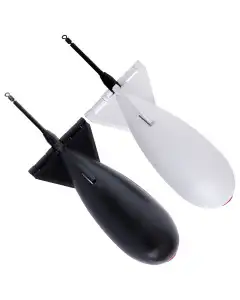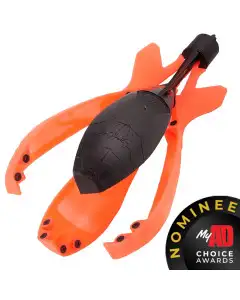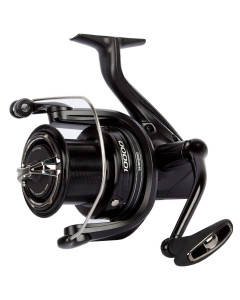This is a demo store. No orders will be fulfilled.
Ultimate Guide to Spod Fishing: Top Tips for Success

Spodding and Spombing have transformed the landscape of carp fishing, providing anglers with advanced bait delivery techniques. Spodding is a fantastic technique carp anglers use to introduce bait into their fishing area. It's a method that allows you to deliver a mix of particles, boilies, and other enticing fishing bait right where you want them.
To help you maximise the effectiveness of this tactic, we've compiled some essential tips for spod fishing success. Whether you're a novice angler or a seasoned pro, this guide delves into the essentials of these baiting tactics to optimise your fishing success.
Understanding Spod Fishing & Spombing
What is Spodding?
Spodding involves using a 'spod' (a rocket-shaped container) to deliver bait accurately to a specific area of water. The primary aim is to lure carp into your targeted fishing zone.


Spodding meaning: The spod is cast out and once it hits the water, it releases the bait.
Spombing meaning: This is a more recent innovation resembling a bomb. The spomb is also filled with bait but has a unique design that ensures a more efficient and leak-proof bait delivery.
Why Use Spodding?
Spodding is beneficial for several reasons. It allows anglers to:
+ Precision: Both techniques offer pinpoint accuracy, allowing you to place bait exactly where you want.
+ Volume: They enable the delivery of large quantities of bait in one go.
+ Versatility: You can use a variety of baits, including particles, boilies, and liquids, introducing a mix of different bait types.
+ Discretion: By minimising disturbance, they ensure a stealthy approach, crucial for not spooking the carp.
+ Economical: This technique can save on bait over time, as you're placing it exactly where it's needed most.
Addressing Concerns about Spodding
- Disturbance: While there’s an initial disturbance when the bait hits the water, regular baiting educates the carp to associate the noise with food.
- Expense: Quality spods and spombs might seem pricey, but they're investments that can elevate your carp fishing game.
How to Spod in Carp Fishing
1. Preparing the Bait


- Choose a mix of particles, pellets, boilies, and even groundbait depending on what you want to introduce to the swim.
- Mix them in a bucket, ensuring they are damp but not overly wet. The consistency should be such that it holds together but can be easily broken up upon impact with water.
- If using groundbait, ensure it's properly mixed and doesn't have any large lumps.
2. Loading the Spod


- Take the spod in one hand.
- Submerge its open end into the bucket of prepared bait.
- Press down, ensuring it fills completely.
- Level off any excess bait, ensuring the spod isn't overloaded.
3. Attaching the Spod to the Rod


- Ensure your spod rod is set up with a braided mainline, as it has less stretch and provides better casting accuracy.
- Use a strong, reliable knot (like a Palomar or loop-to-loop connection) to attach the spod to the end of the mainline or to a leader if you're using one.
- Ensure the connection is secure and test it with a gentle tug.
4. Casting the Fishing Spod Rocket


- Position yourself with a clear casting path.
- With an overhead cast, launch the spod towards your desired spot in the water. It's essential to practice and get comfortable with casting to achieve consistent accuracy.
- As the spod hits the water, it will turn upside down, releasing the bait. The spod then floats back up, allowing for easy retrieval.
- Reel in the spod at a steady pace, ensuring it doesn't snag on any obstacles in the water.
5. Repeating the Process


- Depending on the feeding activity of carp and the size of your swim, you may need to recast the spod several times to create an attractive baited area.
With these steps, spodding becomes an effective way to introduce bait and attract carp to your chosen fishing spot. Regular practice will enhance your proficiency and make the process smoother.
Top 5 Spodding Tips for Effective Bait Delivery
1. Perfect Your Casting Technique
Before going for the real deal, practice your casting technique. Accuracy is key in placing your bait correctly.
It's crucial to cast the spod accurately to ensure that bait lands in the desired location. Begin by practising with your spodding rod in an open water area with minimal obstacles to build your confidence and accuracy.
2. Mix Your Bait Well
The bait mix is essential. Combine various sizes and types of particles, pellets, and boilies. This variety will cater to the diverse preferences of carp and increase the chances of attracting them. Additionally, a well-soaked bait mix ensures that the spod sinks properly and releases the bait efficiently.
3. Use a Braided Line
For spodding, a braided line is preferable. Braided lines, due to their lack of stretch, are preferable to mono. They provide better feedback and aid in accurate casting.
By using a braid line, you ensure a direct connection with the spod, and this makes casting and retrieving more efficient. Remember to use a shock leader to help absorb the force of the cast and protect the mainline.


4. Monitor the Weather
Monitor weather conditions. Weather conditions can significantly influence fish activity and the accuracy of bait deployment.
For instance, on windy days, consider heavier spods or spombs for better control. On warmer days, carp might be found in the upper layers of the water, so a floating bait mix might be ideal. Conversely, during colder times, a heavier mix that sinks might be more productive.
5. Maintain Patience and Consistency
Spodding is as much about patience as it is about technique. It might take time for the fish to get used to the bait area. Consistency in baiting will establish a pattern and draw fish to the spot over time.
6. Choose the Right Spod
Different types are available - open-end spods and closed spods. The choice depends on the bait type and personal preference.
7. Frequency of Baiting Up
Regular and consistent baiting can train the carp to associate the spod's splash with feeding time. On the other hand, be sure not to overfeed the fish.
The Right Spod Fishing Gear Makes a Difference
Your spodding success can also depend on the equipment you use.
Spod Fishing Rod: Invest in a good quality spod rod, which has the strength and flexibility needed to handle the demands of this fishing style. The best spod rod is designed to handle the weight and offer the casting distance needed.
Spod Fishing Reel: Pair it with a robust reel designed for distance casting. Ensure it's loaded with a quality braided line for better performance.
Line for Spod Fishing: Braided lines are a favourite for spodding due to their lack of stretch, ensuring efficient bait delivery.
Spod Rockets: Additionally, spods come in various sizes and designs, so choose one that suits the volume of bait you intend to use and the distance you plan to cast.
Can you fish with a spod rod?
Whilst it's possible to fish with a spod rod, it's not the best tool for the job. It's always recommended to use equipment designed for its intended purpose to maximize efficiency and success.
A spod rod is specifically designed for casting heavy spods (which are bait dispensers) filled with bait. They are built to handle the additional weight and the force exerted when casting these spods over long distances. As a result, spod rods tend to be stiffer and more robust compared to regular carp rods.
It's essential to understand its primary purpose and design considerations. If you decide to fish with a spod rod:
- Tackle Limitations: The stiffer action means it might not be as forgiving when playing a fish, especially near the net. This increases the chance of hook pulls or line breaks.
- Sensitivity: They might not be as sensitive as regular carp rods, which can impact bite detection.
- Line Choice: Spod rods are typically used with braided line for spodding. If you're fishing with one, ensure you switch to a suitable line for the situation.
Can you use a spod reel for fishing?
As with spod rods, you can use a spod reel for fishing, but again, it's important to recognise its primary function and characteristics.
A spod reel is specifically designed to complement a spod rod in casting heavy spods filled with bait over long distances. These reels typically have a large line capacity to accommodate the braided lines often used in spodding and to handle the demands of long-distance casting.
If you decide to fish with a spod reel:


- Line Considerations: Spod reels are usually loaded with braided line, which is excellent for spodding due to its low stretch and direct feel. If you're using the reel for regular fishing, ensure the line is suitable for the situation, or consider re-spooling with a more appropriate line.
- Drag System: Ensure the drag system is adjusted appropriately when playing a fish. Spod reels are designed for casting rather than for playing fish, so you'll need to be more cautious.
- Size and Weight: Spod reels are generally bulkier, which might not provide the most comfortable or balanced setup for standard fishing, especially for extended periods.
Spodding, along with spombing, has profoundly transformed the realm of carp fishing by introducing unmatched precision, efficiency, and versatility in bait delivery. With dedicated practice, the right spod rod and reel, and honed techniques, anglers can significantly boost their catch rate and overall fishing experience.
Embrace the world of spodding, and as you refine your skills, you'll undoubtedly reap the rewards of this game-changing approach.
FAQs on Spod Fishing
How do you fish with SPOD?
Fishing with spod rocket or spomb involves using a rocket-shaped container, called a spod, to deliver bait accurately to a specific area in the water. Cast the spod filled with bait to the desired location, and upon hitting the water, the spod releases the bait to attract fish.
How much shorter should I spod?
Typically, you should spod 1-2 meters shorter than your main fishing spot to ensure that the baited area is slightly in front of where your hook bait will sit.
Does Spodding scare carp?
Initially, Spodding can disturb the water and make carp cautious, but with consistent spodding, carp become accustomed to the noise and associate it with food, making them more confident to approach the baited area.
Can you use a spod rod for carp fishing?
You can use a spod rod for carp fishing, but it's designed primarily for casting spods loaded with bait. While its robust build can handle the weight of carp, its stiffer action might not be as forgiving when playing a fish.
Carp fishing with just a spod rod can potentially lead to hook pulls or line breaks. For optimal carp fishing, it's recommended to use a dedicated carp rod that offers the right balance of sensitivity and strength.
Is mono or braid better for Spodding?
Braid is generally better for Spodding due to its no-stretch property, ensuring a direct connection with the spod and facilitating more efficient casting and retrieving.
How far past your marker should you cast?
You should aim to cast your baited rig about 1-2 meters past your marker to ensure it lands in the baited area after settling, but this can vary depending on specific fishing conditions.
What is the best set up for Spod?
The ideal Spod setup includes a dedicated spod rod with strength and flexibility, paired with a robust reel designed for distance casting, and a braided line. Using a spod tailored to the bait volume and casting distance is also crucial.
Is a marker rod the same as Spod rod?
Spod and marker rods bear a close resemblance. Anglers often find value in acquiring a combo of marker and spod rod, allowing a single rod to serve dual purposes: exploration and bait delivery.















